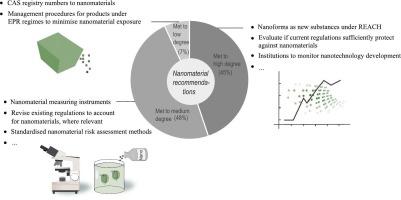NanoImpact ( IF 4.9 ) Pub Date : 2023-10-10 , DOI: 10.1016/j.impact.2023.100487 Maria Bille Nielsen , Lars Skjolding , Anders Baun , Steffen Foss Hansen

|
In 2004, the potential societal implications related to nanotechnology were highlighted in an influential report by the Royal Society and the Royal Academy of Engineering (RS & RAE). It was made clear that legislation is an important tool to tackle the challenges related to nanomaterials and a list of recommendations were put forward. Shortly after, the European Commission also proposed a list of recommendations on how to handle nanomaterial challenges and adopted the so-called “incremental approach”, describing that current legislations should be adapted, where relevant, to handle nanomaterials. Now almost 20 years have passed and it seems relevant to take stock and investigate how legislations have been adapted to tackle nano-specific challenges. In this review, we analyze key pieces of European legislations relevant to nanomaterials and assess to what extent these legislations compare with the original recommendations from 2004 by the RS & RAE and the European Commission. We uncover the cross-cutting challenges that remain and provide recommendations on next steps that should be taken to address the risks of nanomaterials. For each recommendation, we assessed whether it was met to a high, medium or low degree by conducting targeted literature searches at Web of Science, screening legislations, guidance documents, databases etc., and applying expert judgement. We found that >90% of the recommendations put forward in 2004 by the RS & RAE and the European Commission have been either met to a high degree (13 out of 29) or met to a medium degree (14 out of 29). This suggests important advancements in the field of nanosafety. At the same time, it is important to address the concerns still left partly or fully unsolved. Such efforts entail e.g. further development of measuring instruments and standardised characterization and risk assessment methods for nanomaterials, application of a uniform nanomaterial definition, maximization of containment of free nanomaterials until hazards assessed/handled and elimination/minimisation of unintentional nanomaterial emission. Furthermore, we recommend prioritising future efforts to ensure enforcement and implementation of existing nano-specific provisions, as well as revision, where needed, of legislations that currently do not account for nanomaterials, such as the Waste Framework Directive.
中文翻译:

过去 20 年欧洲纳米材料立法——弥合最终差距
2004 年,英国皇家学会和皇家工程院 (RS & RAE) 的一份颇具影响力的报告强调了与纳米技术相关的潜在社会影响。会议明确指出,立法是应对纳米材料相关挑战的重要工具,并提出了一系列建议。不久之后,欧盟委员会还提出了一系列关于如何应对纳米材料挑战的建议,并采用了所谓的“增量方法”,指出应酌情调整现行立法以处理纳米材料。现在已经过去了近 20 年,似乎有必要盘点并调查如何调整立法来应对纳米特定的挑战。在这篇综述中,我们分析了与纳米材料相关的欧洲立法的关键部分,并评估了这些立法与 RS & RAE 和欧盟委员会 2004 年最初建议的比较程度。我们揭示了仍然存在的跨领域挑战,并就应对纳米材料风险应采取的后续步骤提供建议。对于每项建议,我们通过在 Web of Science 上进行有针对性的文献检索、筛选立法、指导文件、数据库等并应用专家判断来评估其是否满足高、中或低程度。我们发现,RS & RAE 和欧盟委员会在 2004 年提出的建议中,超过 90% 已得到高度满足(29 项中的 13 项)或中等程度满足(29 项中的 14 项)。这表明纳米安全领域取得了重要进展。与此同时,解决仍然部分或完全未解决的问题也很重要。这些努力需要进一步开发纳米材料的测量仪器和标准化表征和风险评估方法、应用统一的纳米材料定义、最大限度地遏制游离纳米材料直至评估/处理危害以及消除/最小化无意的纳米材料排放。此外,我们建议优先考虑未来的努力,以确保现有纳米特定条款的执行和实施,并在需要时修订目前不考虑纳米材料的立法,例如《废物框架指令》。



























 京公网安备 11010802027423号
京公网安备 11010802027423号